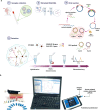Recent trends in carbon nanotube (CNT)-based biosensors for the fast and sensitive detection of human viruses: a critical review
- PMID: 36798507
- PMCID: PMC9926911
- DOI: 10.1039/d2na00236a
Recent trends in carbon nanotube (CNT)-based biosensors for the fast and sensitive detection of human viruses: a critical review
Erratum in
-
Correction: Recent trends in carbon nanotube (CNT)-based biosensors for the fast and sensitive detection of human viruses: a critical review.Nanoscale Adv. 2023 Oct 6;5(21):5983. doi: 10.1039/d3na90097e. eCollection 2023 Oct 24. Nanoscale Adv. 2023. PMID: 37881720 Free PMC article.
Abstract
The current COVID-19 pandemic, with its numerous variants including Omicron which is 50-70% more transmissible than the previously dominant Delta variant, demands a fast, robust, cheap, and easily deployed identification strategy to reduce the chain of transmission, for which biosensors have been shown as a feasible solution at the laboratory scale. The use of nanomaterials has significantly enhanced the performance of biosensors, and the addition of CNTs has increased detection capabilities to an unrivaled level. Among the various CNT-based detection systems, CNT-based field-effect transistors possess ultra-sensitivity and low-noise detection capacity, allowing for immediate analyte determination even in the presence of limited analyte concentrations, which would be typical of early infection stages. Recently, CNT field-effect transistor-type biosensors have been successfully used in the fast diagnosis of COVID-19, which has increased research and commercial interest in exploiting current developments of CNT field-effect transistors. Recent progress in the design and deployment of CNT-based biosensors for viral monitoring are covered in this paper, as are the remaining obstacles and prospects. This work also highlights the enormous potential for synergistic effects of CNTs used in combination with other nanomaterials for viral detection.
This journal is © The Royal Society of Chemistry.
Conflict of interest statement
The authors declare no competing interests.
Figures














Similar articles
-
Toward the Commercialization of Carbon Nanotube Field Effect Transistor Biosensors.Biosensors (Basel). 2023 Feb 27;13(3):326. doi: 10.3390/bios13030326. Biosensors (Basel). 2023. PMID: 36979538 Free PMC article. Review.
-
A triple-aptamer tetrahedral DNA nanostructures based carbon-nanotube-array transistor biosensor for rapid virus detection.Talanta. 2024 Jan 1;266(Pt 1):124973. doi: 10.1016/j.talanta.2023.124973. Epub 2023 Jul 20. Talanta. 2024. PMID: 37506519
-
CNT and Graphene-Based Transistor Biosensors for Cancer Detection: A Review.Biomolecules. 2023 Jun 22;13(7):1024. doi: 10.3390/biom13071024. Biomolecules. 2023. PMID: 37509060 Free PMC article. Review.
-
Graphene-based field-effect transistor biosensors for the rapid detection and analysis of viruses: A perspective in view of COVID-19.Carbon Trends. 2021 Jan;2:100011. doi: 10.1016/j.cartre.2020.100011. Epub 2020 Dec 8. Carbon Trends. 2021. PMID: 38620735 Free PMC article. Review.
-
Decadal Journey of CNT-Based Analytical Biosensing Platforms in the Detection of Human Viruses.Nanomaterials (Basel). 2022 Nov 23;12(23):4132. doi: 10.3390/nano12234132. Nanomaterials (Basel). 2022. PMID: 36500755 Free PMC article. Review.
Cited by
-
Post-CMOS processing challenges and design developments of CMOS-MEMS microheaters for local CNT synthesis.Microsyst Nanoeng. 2023 Nov 6;9:136. doi: 10.1038/s41378-023-00598-w. eCollection 2023. Microsyst Nanoeng. 2023. PMID: 37937184 Free PMC article.
-
Cutting-edge advances in two-dimensional layered double hydroxides: structure, synthesis, functionalization, characterization, and advanced sensor applications.Mikrochim Acta. 2025 Jul 29;192(8):535. doi: 10.1007/s00604-025-07357-w. Mikrochim Acta. 2025. PMID: 40728755 Review.
-
Mini review about metal organic framework (MOF)-based wearable sensors: Challenges and prospects.Heliyon. 2023 Oct 26;9(11):e21621. doi: 10.1016/j.heliyon.2023.e21621. eCollection 2023 Nov. Heliyon. 2023. PMID: 37954292 Free PMC article. Review.
-
Development of an aptasensor for highly sensitive detection of cardiac troponin I using cobalt-nickel metal-organic framework (CoNi-MOF).Heliyon. 2024 Jun 19;10(12):e33238. doi: 10.1016/j.heliyon.2024.e33238. eCollection 2024 Jun 30. Heliyon. 2024. PMID: 39022011 Free PMC article.
-
Advances in the recent application of carbon nanomaterials in triboelectric nanogenerator sensors.Mikrochim Acta. 2025 Aug 7;192(9):567. doi: 10.1007/s00604-025-07411-7. Mikrochim Acta. 2025. PMID: 40773009 Review.
References
-
- Coronaviridae Study Group of the International Committee on Taxonomy of Viruses The species Severe acute respiratory syndrome-related coronavirus: classifying 2019-nCoV and naming it SARS-CoV-2. Nat. Microbiol. 2020;5(4):536–544. doi: 10.1038/s41564-020-0695-z. doi: 10.1038/s41564-020-0695-z. - DOI - DOI - PMC - PubMed
Publication types
LinkOut - more resources
Full Text Sources

